VC nano Z Series Operating Manual
Hardware specifications of VC nano Z Smart Cameras
| Revision: | 2.0.2 |
|---|---|
| Date: | 2023-09-07 |
| Contact: | support@vision-comp.com |
| Copyright: | 1996-2023 Vision Components GmbH Ettlingen, Germany |
| Author: | VC Support, mailto:support@vision-comp.com |

This documentation has been prepared with most possible care. However Vision Components GmbH does not take any liability for possible errors. In the interest of progress, Vision Components GmbH reserves the right to perform technical changes without further notice.
Please notify support@vision-components.com if you become aware of any errors in this manual or if a certain topic requires more detailed documentation.
This manual is intended for information of Vision Component’s customers only. Any publication of this document or parts thereof requires written permission by Vision Components GmbH.
| Symbol | Meaning |
|---|---|
 |
The Light bulb highlights hints and ideas that may be helpful for a development. |
 |
This warning sign alerts of possible pitfalls to avoid. Please pay careful attention to sections marked with this sign. |
 |
This is a sign for an example. |
Trademarks
Linux, Debian, the Tux logo, Vivado, Xilinx and Zynq, ARM, Cortex, Windows XP, Total Commander, Tera Term, Motorola, HALCON, FreeRTOS, Vision Components are registered Trademarks. All trademarks are the property of their respective owners.
Table of Contents
1 General Information
The VC nano Z Series Smart Cameras have been designed for high resolution image processing with a very small form factor. They are the ideal compromise between high performance and low system costs, and thus especially suited for high volume OEM applications. This makes them viable to use a smart camera in even more products than before.
Based on a dual-core processor ARM® Cortex®-A9 with 866 MHz and an integrated FPGA the models of the new VC Z series offer solutions at extreme high-speed in real-time.
The operating system VC Linux provides for the ideal interaction of hard- and software.
All cameras are equipped with a battery backed real time clock and come with 2 inputs and 4 outputs, with trigger input and flash trigger output, as well as an Ethernet interface. 5 different CMOS sensors (the image resolution can be changed to the ROI required) with global shutter and a resolution up to 4.2 Megapixel are available with all models.
The extremely low power consumption of only 1.7W makes this camera ideally suitable for use in mobile devices.
2 Technical Specifications
2.1 Technical Specifications VC nano Z
| Component / Feature | Specification |
|---|---|
| CMOS Sensor |
|
| Active pixels |
|
| Pixel size |
|
| Active sensor size |
|
| High-speed shutter |
|
| Low-speed shutter |
|
| Integration | Global shutter |
| Picture taking | program-controlled or external high speed trigger, jitterfree acquisition
|
| A/D conversion | 118.75 MHz / 10 bit, only the 8 most significant bits used for grey values |
| Input LUT | yes |
| Image Display | Via 100 Mbit Ethernet onto PC |
| Processor | Dual-Core ARM® Cortex®-A9 with 866MHz and integrated FPGA |
| RAM | 512 MB DDR-SDRAM |
| Flash EPROM | 16 GB flash memory (nonvolatile) |
| Process interface | 2 inputs / 4 outputs, outputs 4x400 mA |
| Trigger | 1 picture trigger input, 1 flash trigger output, 24V |
| Ethernet interface | 100 Mbit |
| Serial interface | Not available |
| CE certification | CE Certification from Vision Components |
| Storage Conditions | Temperature: -20 to +60 deg C, Max. humidity: 90%, non condensing. |
| Operating Conditions | Temperature: 0 to +50 deg C, Max. humidity: 80%, non condensing. |
| Power Supply | 12-24V DC, max. 300 mA |
| Power Consumption | approx. 2.4W |
The following diagram shows the maximum reachable (with the shortest shutter time) framerate according to the number of captured lines for the VC nano Z 0010, the VC nano Z 0011, the VC nano Z 0015, the VC nano Z 0252 and the VC nano Z 0273:
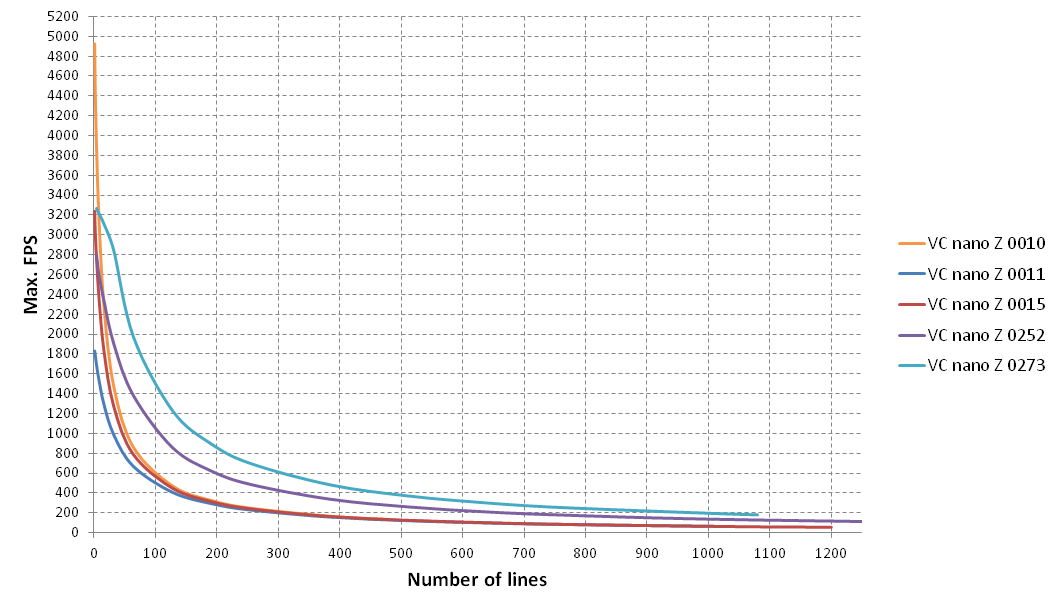
Frames per second over number of lines
The following table gives some example values.
| VC nano Z 0010 | VC nano Z 0011 | VC nano Z 0015 | VC nano Z 0252 | VC nano Z 0273 | |||||
|---|---|---|---|---|---|---|---|---|---|
| Resolution | Max. framerate (FPS) | Resolution | Max. framerate (FPS) | Resolution | Max. framerate (FPS) | Resolution | Max. framerate (FPS) | Resolution | Max. framerate (FPS) |
| 2048 x 1536 | 88 | ||||||||
| 1600 x 1200 | 55 | ||||||||
| 1440 x 1080 | 181 | ||||||||
| 1280 x 1024 | 63 | 1600 x 1024 | 63 | 2048 x 1024 | 134 | 1440 x 1024 | 191 | ||
| 1280 x 768 | 83 | 1600 x 768 | 84 | 2048 x 768 | 177 | 1440 x 768 | 252 | ||
| 1280 x 640 | 98 | 1600 x 640 | 101 | 2048 x 640 | 210 | 1440 x 640 | 300 | ||
| 736 x 480 | 134 | 1280 x 512 | 121 | 1600 x 512 | 125 | 2048 x 512 | 260 | 1440 x 512 | 370 |
| 736 x 384 | 167 | 1280 x 384 | 158 | 1600 x 384 | 164 | 2048 x 384 | 338 | 1440 x 384 | 483 |
| 736 x 256 | 246 | 1280 x 256 | 228 | 1600 x 256 | 240 | 2048 x 256 | 485 | 1440 x 256 | 695 |
| 736 x 192 | 323 | 1280 x 192 | 292 | 1600 x 192 | 312 | 2048 x 192 | 619 | 1440 x 192 | 890 |
| 736 x 128 | 470 | 1280 x 128 | 406 | 1600 x 128 | 447 | 2048 x 128 | 856 | 1440 x 128 | 1227 |
| 736 x 64 | 861 | 1280 x 64 | 669 | 1600 x 64 | 788 | 2048 x 64 | 1382 | 1440 x 64 | 1974 |
| 736 x 32 | 1473 | 1280 x 32 | 986 | 1600 x 32 | 1272 | 2048 x 32 | 1903 | 1440 x 32 | 2843 |
| 736 x 16 | 2288 | 1280 x 16 | 1295 | 1600 x 16 | 1836 | 2048 x 16 | 2340 | 1440 x 16 | 3112 |
| 736 x 8 | 3158 | 1280 x 8 | 1535 | 1600 x 8 | 2359 | 2048 x 8 | 2598 | 1440 x 8 | 3215 |
| 736 x 4 | 3901 | 1280 x 4 | 1691 | 1600 x 4 | 2765 | 2048 x 4 | 2797 | 1440 x 4 | 3267 |
| 736 x 2 | 4422 | 1280 x 2 | 1783 | 1600 x 2 | 3015 | 2048 x 2 | N/A | 1440 x 2 | N/A |
| 736 x 1 | 4925 | 1280 x 1 | 1832 | 1600 x 1 | 3238 | 2048 x 1 | N/A | 1440 x 1 | N/A |
Note

- The measurements were done without any other CPU load. Parallel image processing tasks may lead to a lower framerate.
- These values are only reachable by limiting the maximum image acquisition size at capture initialisation, as explained on this page: Image Acquisition (scroll down to "Changing the Sensor ROI").
3 Camera Interfaces

Connector Positions
The VC nano Z Series cameras incorporate the following connector interfaces:
- LAN / Ethernet interface
- PLC IO, power supply and trigger interface
The pin assignments, electrical specifications as well as available accessories are shown for each interface connector in the following sections.
3.1 LAN / Ethernet Interface
3.1.1 Pin Assignments LAN / Ethernet Interface
| Camera Socket | Pin at Camera | Signal | 20m Patch Cable Wire | 10m Patch Cable Wire | Pin at PC |
|---|---|---|---|---|---|
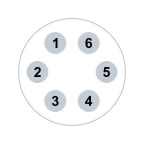 |
2 | Tx+ | yellow | white/pink | 1 |
| 1 | Tx- | orange | pink | 2 | |
| 6 | Rx+ | white/green | white/green | 3 | |
| 5 | Rx- | green | green | 6 | |
| 3 | — | — | — | NC | |
| 4 | — | — | — | NC |

The colors are for cables sold by us. Refer to the Accessories section for a list of available cables with order numbers.
3.2 Power Supply, I/O interface and trigger interface
This connector includes the camera Power Supply, the digital PLC IOs and the trigger interface.
3.2.1 Pin assignments Power Supply and IO Interface
| Camera Socket | Pin | Signal | Cable Colors |
|---|---|---|---|
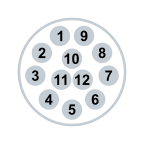 |
1 | 12-24V PLC | red |
| 2 | 12-24V IN Cam | red / blue | |
| 3 | GND IN com. | black. | |
| 4 | INP 1 | pink | |
| 5 | OUT 3 | yellow | |
| 6 | OUT 2 | green | |
| 7 | OUT 1 | brown | |
| 8 | OUT 0 | white | |
| 9 | 12-24V PLC | grey / pink | |
| 10 | TrigOut | purple | |
| 11 | TrigIn | blue | |
| 12 | INP 0 | grey |
3.2.2 Electrical specifications Camera Power Supply
Warning
 With the VC nano Z Series cameras the PLC supply contacts are
internally connected with the camera power supply pin 2. In this case
pin 1 and 9 require the same voltage level as the camera power supply
pin 2. Refer to section 4.2.3 for details on the different PLC interface
features.
With the VC nano Z Series cameras the PLC supply contacts are
internally connected with the camera power supply pin 2. In this case
pin 1 and 9 require the same voltage level as the camera power supply
pin 2. Refer to section 4.2.3 for details on the different PLC interface
features.
| What | How much |
|---|---|
| Nominal Voltage | 12 – 24 V |
| Absolute Voltage Limits | 9 V - 30 V |
| Minimum nominal Operating voltage and corresponding current | 12V, 160 mA |
| Maximum nominal Operating voltage and corresponding current | 24V, 90 mA |
| Nominal Power Consumption | 2.2W |
In general the camera power supply is regulated in the camera, so an unregulated power source is sufficient. However the absolute voltage levels specified above should never be exceeded.
In case of unstable power supply (voltage spikes or power interruptions) it is recommended to back up the power supply by a capacitor or a battery large enough to prevent power interruptions.
It is recommended to switch on the low voltage supply (12 to 24V) when booting the camera. Some 110/ 220V power supplies increase the output voltage too slow or drop the voltage under load at startup which might cause the camera not to boot properly! A power supply able to supply a much higher than nominal boot current for a few milliseconds may be an alternative approach.
3.2.3 Electrical Specifications digital PLC IO / trigger Interface
Note

Activation of trigger output is done by assigning the right GPIO via the command line tool named vcio, see GPIOs and Trigger Assignment for more information.
The VC nano Z Series Smart Cameras feature digital inputs and outputs that allow e.g. direct input of light barriers signals or the control of pneumatic valves, as well as a trigger input and output.
Please observe the current and voltage ratings specified in the following sections.
Separation of PLC/trigger output voltage  |
PLC outputs supply not separated from power supply |
| PLC/trigger Input Voltage | Identical with power supply voltage |
| PLC/trigger Input Current (max) | 1.0 mA at 12V to 2.0mA @ 24V |
| PLC/trigger Output Voltage | Identical with power supply Voltage — internally connected |
| PLC/trigger Output Current (max) | 4 x 400 mA Max total of all outputs: 1A |
| Max Current for 1 Power / PLC connector pin | 500 mA |
| Power failure detection | — |
Warning
 When using the PLC/trigger outputs connect all camera supply
and PLC supply pins (pin 1, pin 2 and pin 9) in order to limit the
connector pin current.
When using the PLC/trigger outputs connect all camera supply
and PLC supply pins (pin 1, pin 2 and pin 9) in order to limit the
connector pin current.
The maximum combined current of all outputs should not exceed 1 A.
3.2.3.1 Connection of PLC/trigger inputs VC nano Z Series
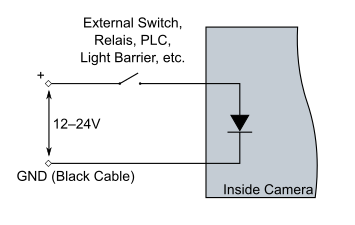
Connection of Trigger Inputs
- 2 digital inputs
- 1 trigger input
- Operating Voltage 12 to 24 V
- Threshold Voltage 8V (input high for signals greater 8V)
- Maximum Voltage: 30V
- Reverse voltage protection
- Input Current 2mA @ 24V
- Signal debouncing hardware: none
3.2.3.2 Connection of PLC/trigger outputs VC nano Z Series
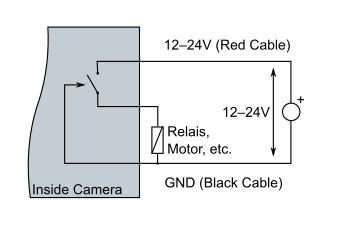
Connection of Trigger Outputs
- 4 digital outputs
- 1 trigger output
- Operating Voltage 12 to 24 V
- current per output: 400 mA (total current all outputs < 1000 mA)
- Connect 12-24 V PLC and camera power supply pins 1, 2 and 9.
- bit = 1 output will switch positive voltage
- short-circuit and over- temperature protection (2A)
The outputs are protected with an Infineon BSP742R power switch (http://www.infineon.com/dgdl/Infineon-BSP742R_GDS-DS-v01_03-en.pdf?fileId=db3a304320d39d5901210fe1d994367c).
3.2.4 Available Accessories / Cables for Power Supply and IO Interface

Equipped on one end with a Hirose plug jack, length 5m, 10m or 25m
Refer to section 5.1 for a list of available cables with order numbers.
3.3 VC nano Z Series LED
The VC nano Z Smart Cameras feature 8 LEDs providing status information on power supply, PLC I/Os and trigger input.
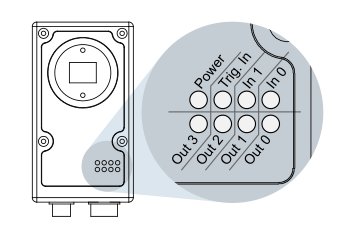
4 Software Interfaces
4.1 GPIOs
| GPIO Nr. | Pin Designator | Usability | Remark |
|---|---|---|---|
| 0 | OUT 0 | Output | — |
| 1 | OUT 1 | Output | — |
| 2 | OUT 2 | Output | — |
| 3 | OUT 3 | Output | — |
| 4 | — | — | — |
| 5 | — | — | — |
| 6 | — | — | — |
| 7 | — | — | — |
| 8 | — | — | — |
| 9 | — | — | — |
| 10 | INP 0 | Input | — |
| 11 | INP 1 | Input | — |
| 12 | — | — | — |
| 13 | — | — | — |
| 14 | — | — | — |
| 15 | — | — | — |
| 16 | — | — | — |
| 17 | — | — | — |
| 18 | — | — | — |
| 19 | — | — | — |
| 20 | — | — | — |
| 21 | — | — | — |
| 22 | — | — | — |
| 23 | — | — | — |
| 24 | — | — | — |
| 25 | — | — | — |
| 26 | — | — | — |
| 27 | — | — | — |
| 28 | — | — | — |
| 29 | — | — | — |
| 30 | — | — | — |
| 31(Out) | TrigOut | Output | — |
| 31(In ) | TrigIn | Input | Optically isolated |
They can be accessed over the linux standard way via /sys/class/gpio, see https://www.kernel.org/doc/Documentation/gpio/sysfs.txt. The GPIO numbers are relative to the start number of the gpiochip labelled with '/amba@0/axi-gpio0@41200000', here: /sys/class/gpio/gpiochip224.
4.2 Trigger Assignment
To choose the sensor input/output trigger signals, the corresponding GPIO Nr. must be determined and assigned by the supporting program named vcio. More information can be found at the help of the program, if you run it with no command line parameter, it will show how to do it. Sample usage instructions are provided here, but always refer to the instructions of your version:
VCIO v.1.2.3.- VCLinux Camera I/O Configuration and Connection Setup.
Usage: vcio [-s sen] [-i gpioNr] [-n] [-o gpioField] [-d gpioField] [-t time]
-s Sensor to be configured, default value: 0. -i GPIO Nr. to be used as external sensor trigger input (TRGSRC_EXT) -n Negates trigger input signal -o Bitfield of GPIOs which are coupled with sensor trigger output signal. The bit of GPIO Nr. X is coupled, if Bit X is set to 1, for example, For coupling GPIO Nr. 0, 3 and 31 (TrigOut) provide the Bitfield as Decimal Value: 2^0+2^3+2^31=2147483657, as Hex Value: 0x80000009, or as Binary Value: 0b10000000000000000000000000001001. -d The direction of the GPIOs as bitfield (see -o switch); If the GPIO Nr. X should be configured as output, set bit X to 1, and if it should be an input, set bit X to 0. -t Time used to debounce all input sources, default value: 10000. Time Unit is in FPGA Cycles. The FPGA clock frequency can be acquired by reading out the value of capt->sen->d.fpgaClkHz, e.g. 153846161 Hz. The default debouncing time for that example is then given by 10000 cycles / 153846161 Hz = 0.000065 s = 65 us. Settings done cannot be read out. Different camera models may have different vcio parameters.
Example
 If an additional flash device is connected to Pin OUT 1,
the 'Connector Assignment of GPIOs' table shows the corresponding GPIO Nr.: 1.
To link the gpio Nr. 1 to the sensor trigger signal, the 'vcio' program must make the gpio Nr. 1 an
output gpio (-d) and couple it to the sensor trigger signal (-o), for example,
the following call uses the TrigOut pin (gpio Nr. 31) and the OUT 1 pin
(gpio Nr. 1) for simultaneous flash output, the external input trigger is coming
from gpio Nr. 10, which is, by table, the hardware pin of INP 0:
If an additional flash device is connected to Pin OUT 1,
the 'Connector Assignment of GPIOs' table shows the corresponding GPIO Nr.: 1.
To link the gpio Nr. 1 to the sensor trigger signal, the 'vcio' program must make the gpio Nr. 1 an
output gpio (-d) and couple it to the sensor trigger signal (-o), for example,
the following call uses the TrigOut pin (gpio Nr. 31) and the OUT 1 pin
(gpio Nr. 1) for simultaneous flash output, the external input trigger is coming
from gpio Nr. 10, which is, by table, the hardware pin of INP 0:
vcio -d 0b10000000000000000000000000000010 -o 0x80000002 -i 10
One can further switch flash outputs for each capture (see the libvclinux documentation: VCFlashSelector); therefore the corresponding gpios must be set as output (-d), but they should not be coupled with the trigger signal (-o), since this given value would be ORed with the flash selector settings, and the flash would always trigger.
Note

To actually use the trigger input source (assigned by the vcio program) you have to select it at your source code in your image capture struct by setting the capture trigger input source to TRGSRC_EXT (instead of TRGSRC_IMM for immediate trigger); refer to the libvclinux image acquisition documentation! You may also invert the trigger signal first, see Output Trigger Signal Inversion
| GPIO Nr. | Pin Designator | Assignment |
|---|---|---|
| 31(Out) | TrigOut | Trigger Output |
| 31(In ) | TrigIn | Trigger Input |
4.2.1 Output Trigger Signal Inversion
One can invert the value of the trigger output signal by writing a 1 onto the corresponding GPIO nr, for example via the program 'vcgpio'. To get usage instruction for the program vcgpio run it without any parameters. The figure shows how it is applied.
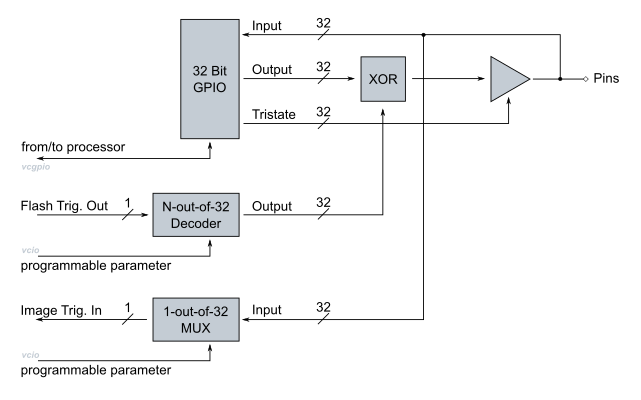
VC nano Z I/O Circuit
5 Accessories
5.1 Camera order numbers
The VC nano Z Series Smart Cameras support by default CS-mount lenses, but standard delivery also includes a 5 mm adjustment ring for C-mount lenses.
| Order Number | Product / Service description |
|---|---|
| VK002247 | VC nano Z 0010 Smart Camera, b/w sensor |
| VK002114 | VC nano Z 0011 Smart Camera, b/w sensor |
| VK002130 | VC nano Z 0011 Smart Camera, Bayer sensor |
| VK002183 | VC nano Z 0015 Smart Camera, b/w sensor |
| VK002186 | VC nano Z 0015 Smart Camera, Bayer sensor |
| VK003120 | VC nano Z 0252 Smart Camera, b/w sensor |
| VK003155 | VC nano Z 0252 Smart Camera, Bayer sensor |
| VK000465 | VC nano Z 0273 Smart Camera, b/w sensor |
| VK003164 | VC nano Z 0392 Smart Camera, b/w sensor |
Further models will be offered.
5.2 Order numbers of all available VC nano Z Series Accessories
| Article Description | Order Number | Camera Connector | Second Connector |
|---|---|---|---|
| 5m LAN-C6-Cable | VK000149 | HRS connector female 6 pin
 |
RJ45
 |
| 10m LAN-C6-Cable | VK000150 | HRS connector female 6 pin | RJ45 |
| 25m LAN-C6-Cable | VK000151 | HRS connector female 6 pin | RJ45 |
| Ethernet Cross Module | VK000156 | RJ45
 |
RJ45 female socket |
| Article Description | Order Number | Camera Connector | Second Connector |
|---|---|---|---|
| 5m Power / PLC-Cable C6 | VK000008 | HRS female 12 pin
 |
without connector
 |
| 10m Power / PLC-Cable C6 | VK000114 | HRS female 12 pin | without connector |
| 25m Power / PLC-Cable C6 | VK000161 | HRS female 12 pin | without connector |
| Article Description | Order Number | Camera Connector |
|---|---|---|
| Power Adapter C6 24V, with 12 pins conn. 3m | VK000119 | HRS connector female 12 pin
 |
| Power adapter for rail mounting, Input Voltage 100 - 240VAC 50/60 Hz, Output Voltage DC 24V +/-5%, max. 300 mA (7.5 W), Equipped with connecting clamps for AC input and 24V output, CE cert. | VK000036 |  |
Please also refer to the VC website **www.vision-components.com** for an up to date list of accessories.
6 Appendix A: Block diagram VC nano Z Series
The image is formed by a 1.3 megapixel CMOS sensor (VC nano Z 0011). The image is then stored in the DDR3-SDRAM memory, which has been increased to 512 MB.
The VC nano Z Series cameras do not have a direct video output. However if monitoring of the camera image is required, this can be done by transferring via Fast Ethernet port to PC and display on screen.
Block diagram VC nano Z Series:
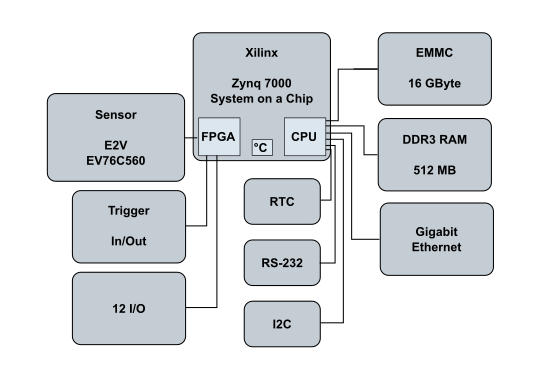
7 Appendix B: Dimensions VC nano Z Series
Warning
 Maximal torque for M6 screws: 10 Nm.
Maximal torque for M6 screws: 10 Nm.

Tolerances: All circuit board dimensions: +/- 0.1
